There are a lot of things the fourth smartphone in Samsung’s halo Galaxy S series is not. It’s not a reinvention, or a revolution. If it were a movie, the Galaxy S 4 wouldn’t be the blockbuster revival of a flagging film franchise: the reboot that kicks a sagging series back into high gear.
That’s because the Galaxy S line has never been a disappointing one. For years, Samsung’s flagship smartphone series has dominated the Android landscape, making the word “Galaxy” synonymous with Google’s platform in much of the public vernacular. Last year’s GalaxyS III accelerated that trend, bringing an avalanche of new features stuffed into some of the most advanced hardware available, and earning high praise in our reviews.
This year, Samsung seems reluctant to fix what ain’t broke. The Galaxy S 4 evidences a conservative approach to evolution in a world that demands a new flagship phone every year, necessary or not. It looks, feels, and even acts a lot like its predecessor – but don’t judge a smartphone by its casing: there’s a lot of new material here. From specs to styling, the S 4 is the epitome of an ultra-modern Android smartphone.
The important question then arises: is it a good smartphone? We spent seven painstaking days finding out. Join us as we examine the ins and outs of one of the year’s most anticipated mobile devices. Join us as we deconstruct the Samsung Galaxy S 4.
Videos · Specs · Hardware · UI · Camera · Performance · Battery Life · Call/Network · Pricing/Availability · Conclusion · Scored For Me
Video Review & Comparisons
Specs
Samsung may have ditched the Roman numerals for its fourth Galaxy S, but this is still very much a phone built on numbers. Bignumbers. Buyers of most international versions of the Galaxy S 4 will be treated to Samsung’s latest and greatest powering it all: an Exynos 5 Octa CPU packing eight cores of processing performance. That’s a monster chip, and we’re looking forward to spending some hands-on time with the global unit to see how it fares – but our Sprint review unit wasn’t quite as well-endowed. That’s because the U.S. version of the Galaxy S 4 sports a quad-core Qualcomm Snapdragon 600 CPU instead. That’s the same chip found in the Sprint HTC One we reviewed a few weeks back, but this one is clocked at a zippy 1.9GHz. It’s also backed up by 2GB of RAM and the typical 16, 32, or 64GB of storage – our demo unit is the 16GB version, which offers about 9.6GB of free space to the user on first boot. Fortunately, that’s expandable via microSD to an additional 64GB, which should please all but the most hoardacious of media hoarders. If this all sounds a bit familiar, it should: this storage spread has been Samsung’s typical offering for quite a while. Along with the user-replaceable 2600mAh battery, the Galaxy S 4 strikes the perfect balance of built-in utility and after-purchase expansion for both average and power users.
That’s because the U.S. version of the Galaxy S 4 sports a quad-core Qualcomm Snapdragon 600 CPU instead. That’s the same chip found in the Sprint HTC One we reviewed a few weeks back, but this one is clocked at a zippy 1.9GHz. It’s also backed up by 2GB of RAM and the typical 16, 32, or 64GB of storage – our demo unit is the 16GB version, which offers about 9.6GB of free space to the user on first boot. Fortunately, that’s expandable via microSD to an additional 64GB, which should please all but the most hoardacious of media hoarders. If this all sounds a bit familiar, it should: this storage spread has been Samsung’s typical offering for quite a while. Along with the user-replaceable 2600mAh battery, the Galaxy S 4 strikes the perfect balance of built-in utility and after-purchase expansion for both average and power users.
 That’s because the U.S. version of the Galaxy S 4 sports a quad-core Qualcomm Snapdragon 600 CPU instead. That’s the same chip found in the Sprint HTC One we reviewed a few weeks back, but this one is clocked at a zippy 1.9GHz. It’s also backed up by 2GB of RAM and the typical 16, 32, or 64GB of storage – our demo unit is the 16GB version, which offers about 9.6GB of free space to the user on first boot. Fortunately, that’s expandable via microSD to an additional 64GB, which should please all but the most hoardacious of media hoarders. If this all sounds a bit familiar, it should: this storage spread has been Samsung’s typical offering for quite a while. Along with the user-replaceable 2600mAh battery, the Galaxy S 4 strikes the perfect balance of built-in utility and after-purchase expansion for both average and power users.
That’s because the U.S. version of the Galaxy S 4 sports a quad-core Qualcomm Snapdragon 600 CPU instead. That’s the same chip found in the Sprint HTC One we reviewed a few weeks back, but this one is clocked at a zippy 1.9GHz. It’s also backed up by 2GB of RAM and the typical 16, 32, or 64GB of storage – our demo unit is the 16GB version, which offers about 9.6GB of free space to the user on first boot. Fortunately, that’s expandable via microSD to an additional 64GB, which should please all but the most hoardacious of media hoarders. If this all sounds a bit familiar, it should: this storage spread has been Samsung’s typical offering for quite a while. Along with the user-replaceable 2600mAh battery, the Galaxy S 4 strikes the perfect balance of built-in utility and after-purchase expansion for both average and power users.
Samsung’s got the sensor-and-transmitter arena locked down, as well: the Galaxy S 4 is a regular Star Trek tricorder. In addition to the typical accelerometer, gyro, and magnetometer, the S 4 offers a thermometer, barometer, and hygrometer for atmospheric measurements, as well as an IR blaster for TV and entertainment-center control. The WiFi radio features support for 802.11 ac alongside the typical a/b/g/n, the Bluetooth array is version 4.0, and NFC is here alongside American CDMA and LTE radios optimized for Sprint’s network. About the only thing missing is wireless charging, which Samsung says will come courtesy of a new battery cover later in the year (for a modest fee, of course).
Hardware
 That all this equipment can find a home in a device as small and light as this is a testament to Samsung’s manufacturing prowess. The company has long maintained that if you’re going to carry a smartphone all day long, it should be as portable as possible, and the Galaxy S 4 is definitely the lightest phone in its class. At 130g, it almost feels like a retail dummy in the hand, rather than a functioning smartphone – and we get the impression that Samsung would have made the 7.9mm-thin device even lighter if it could have. That’s how serious the company is about portability.
That all this equipment can find a home in a device as small and light as this is a testament to Samsung’s manufacturing prowess. The company has long maintained that if you’re going to carry a smartphone all day long, it should be as portable as possible, and the Galaxy S 4 is definitely the lightest phone in its class. At 130g, it almost feels like a retail dummy in the hand, rather than a functioning smartphone – and we get the impression that Samsung would have made the 7.9mm-thin device even lighter if it could have. That’s how serious the company is about portability.
Last year’s Galaxy S III suffered in this respect: it felt a bit cheap in the hand as a result of its light weight combined with its glossy exterior. Samsung has mitigated that problem somewhat with enhanced styling in the S 4, lining the device’s edge with a thicker faux-metal trim rail accented by a narrow ring that shines brilliantly in the sunlight. The “hairline metallic” finish we saw on last year’s devices has been replaced with a stippled diamond texture, and the volume, home, and power buttons all feature better travel and response than on previous devices. Samsung’s Hyperglaze coating is just as shiny and fingerprint-loving as ever, though, and it’s verysuceptible to scratches and scuffs. That, combined with the somewhat hollow feel in the hand, means the Galaxy S 4 doesn’t completely escape the toy-like feel of its predecessor.
 Fortunately, that feeling completely evaporates when the screen flickers to life. The Galaxy S 4′s Super AMOLED panel, nestled securely behind a sheet of Gorilla Glass 3, is a stunner. At 1080p resolution, it offers a display density of 441 pixels per inch. That’s not quite as high as the HTC One’s 468 ppi, but that’s because the Galaxy S 4′s display is larger, at 4.99 inches on the diagonal. In any event, the difference in pixel density is academic; the human eye stops distinguishing individual pixels right in this neighborhood, so at the density levels we’re talking, the issue of which device “wins” is more a question of bragging rights than a relevant talking point. The bottom line is that the Galaxy S 4′s panel is beautiful, with the deep blacks and lush saturation common to AMOLED screens, and it’s big – but thanks to the hardware’s narrow bezels, it’s still manageable. In fact, it’s the first 5-inch screen we’ve felt completely comfortable using with one hand. That’s a big deal.
Fortunately, that feeling completely evaporates when the screen flickers to life. The Galaxy S 4′s Super AMOLED panel, nestled securely behind a sheet of Gorilla Glass 3, is a stunner. At 1080p resolution, it offers a display density of 441 pixels per inch. That’s not quite as high as the HTC One’s 468 ppi, but that’s because the Galaxy S 4′s display is larger, at 4.99 inches on the diagonal. In any event, the difference in pixel density is academic; the human eye stops distinguishing individual pixels right in this neighborhood, so at the density levels we’re talking, the issue of which device “wins” is more a question of bragging rights than a relevant talking point. The bottom line is that the Galaxy S 4′s panel is beautiful, with the deep blacks and lush saturation common to AMOLED screens, and it’s big – but thanks to the hardware’s narrow bezels, it’s still manageable. In fact, it’s the first 5-inch screen we’ve felt completely comfortable using with one hand. That’s a big deal. Again, there’s nothing mind-blowing about the Galaxy S 4′s design or materials compared to its forebears (or, for that matter, its competition). The innovative aspect of the device is its inclusion of so much in such a small package – a package that, just like Sprint’s HTC One, is devoid of carrier branding on the Now Network. That package probably won’t turn too many heads in retail stores -indeed, we publicly carried the Galaxy S 4 for a week with no one noticing- but the feature list taped to the shelf underneath it probably will.
Again, there’s nothing mind-blowing about the Galaxy S 4′s design or materials compared to its forebears (or, for that matter, its competition). The innovative aspect of the device is its inclusion of so much in such a small package – a package that, just like Sprint’s HTC One, is devoid of carrier branding on the Now Network. That package probably won’t turn too many heads in retail stores -indeed, we publicly carried the Galaxy S 4 for a week with no one noticing- but the feature list taped to the shelf underneath it probably will.UI
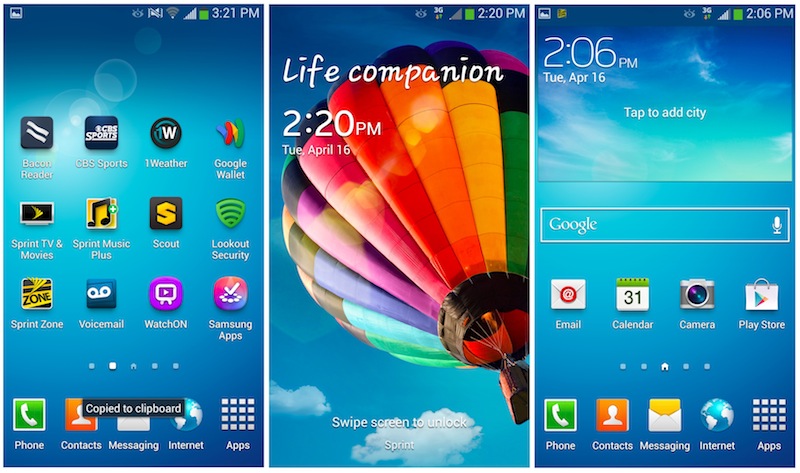 Those features are displayed front-and-center by a software load that -wait for it- isn’t much different, either. Our test unit runs the newest version of the TouchWiz Nature UX atop Android 4.2.2, and with the exception of a small tweak here and there, it looks exactly the same as earlier versions of Samsung’s skin. Those who appreciate the colorful, clear accents of TouchWiz can rest easy; those who were hoping that Samsung’s software would graduate to a less-cartoony look will have to wait.
Those features are displayed front-and-center by a software load that -wait for it- isn’t much different, either. Our test unit runs the newest version of the TouchWiz Nature UX atop Android 4.2.2, and with the exception of a small tweak here and there, it looks exactly the same as earlier versions of Samsung’s skin. Those who appreciate the colorful, clear accents of TouchWiz can rest easy; those who were hoping that Samsung’s software would graduate to a less-cartoony look will have to wait. Some of the tweaks the company has made to its interface are extremely useful: the notification toggles we’ve waxed poetic about have been enhanced. Users can now choose which buttons they want displayed, and arrange them according to what order they find most useful. Samsung said that wireless providers still have input into how the notification tray is used, so we can probably expect more meddling with the WiFi togglefrom certain carriers, but at least the rest of the switchboard has been opened up to user modification.
Some of the tweaks the company has made to its interface are extremely useful: the notification toggles we’ve waxed poetic about have been enhanced. Users can now choose which buttons they want displayed, and arrange them according to what order they find most useful. Samsung said that wireless providers still have input into how the notification tray is used, so we can probably expect more meddling with the WiFi togglefrom certain carriers, but at least the rest of the switchboard has been opened up to user modification.
Samsung has also included an Easy Mode for customers new to smartphones. This setting strips the home screen down to its essential elements, replacing widgets and shortcuts with oversized buttons painted in a bright, simple palette. The simplification even extends further to core apps like the calendar. It’s not pretty, but it is responsive and easy to use – necessary to Samsung’s goal of making the Galaxy S 4 a phone you can recommend not just to tech-savvy friends, but to your parents as well.
The company’s efforts at simplifying outside the Easy Mode meet with mixed results. We criticized Samsung’s Settings menu last year for its convoluted layout, and the tabbed approach it’s taken with this year’s iteration might eventually work, but the categories are still confusingly labeled and the experience isn’t at all straightforward. Odd tweaks have also been made elsewhere: the dialer is now white instead of black for some reason, which is jarring when compared with the darker theme of much of the rest of the UI. The result is a disjointed experience.
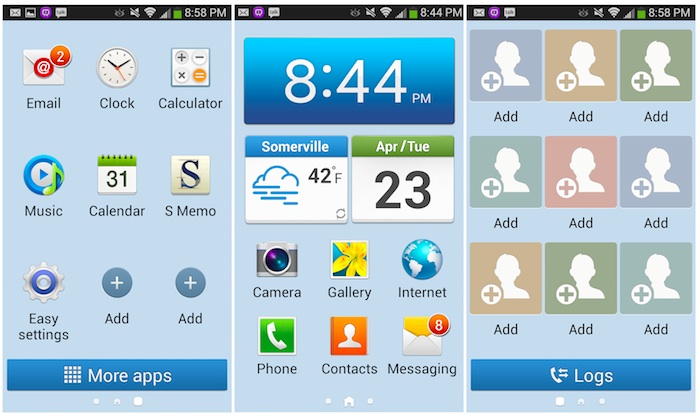
Swipes and Shakes: The Gesture Component
What Samsung misses in terms of aesthetic unity, it makes up for in added features. Like the Galaxy S III before it, the Galaxy S 4 broke cover with a bevy of new capabilities, many of them lifted wholesale from the Galaxy Note II. Multi-screen multitasking is here, which is handy, as are the eyeball-tracking Smart Stay and Smart Scroll – which are … less handy. It’s a bit charitable to call those latter gimmicks “features,” as they work only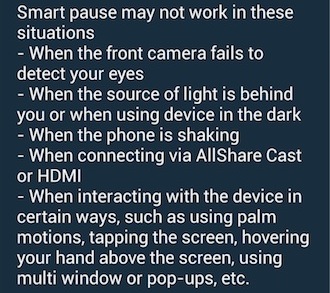 intermittently and come trailing a long list of caveats. To Samsung’s credit, it clearly calls out these limitations in big dialog boxes – but with so many impediments, we were left wondering how so many of these “assets” made it to release in the first place. Some almost feel like beta versions.
intermittently and come trailing a long list of caveats. To Samsung’s credit, it clearly calls out these limitations in big dialog boxes – but with so many impediments, we were left wondering how so many of these “assets” made it to release in the first place. Some almost feel like beta versions.
 intermittently and come trailing a long list of caveats. To Samsung’s credit, it clearly calls out these limitations in big dialog boxes – but with so many impediments, we were left wondering how so many of these “assets” made it to release in the first place. Some almost feel like beta versions.
intermittently and come trailing a long list of caveats. To Samsung’s credit, it clearly calls out these limitations in big dialog boxes – but with so many impediments, we were left wondering how so many of these “assets” made it to release in the first place. Some almost feel like beta versions.
A good example of a well-intentioned but half-baked feature is Air Gesture, which allows users to wave a hand close to the screen to interact with the phone. It’s a great idea for those who want to avoid smudging up their device, but it frequently misfires and scrolls when we don’t want it to. The companion feature, Air View, works well on the Galaxy Note II and we were excited to hear Samsung was bringing a pen-less version of it to the Galaxy S 4. But Samsung botched the port to the newer phone, resulting in a glitchy experience that only works on some elements, some of the time. Samsung was good enough to send us a replacement review unit when we thought these problems might be indicative of a bad demo phone, but they weren’t. The features are just buggy.
(Update: While we still maintain that many of the Galaxy S 4′s features are poorly implemented, the Air View behavior we refer to above is a feature, not a bug. Air View only displays content in hovering windows when necessary.)
Samsung Hub and WatchON: The Content Play
 The bigger-picture enhancements are more impressive, relatively speaking. Samsung appears to be redoubling its efforts to shoulder its way into your content world, and it’s placed its Samsung Hub prominently on one of the Galaxy S 4′s home screens just for that purpose. The Hub serves as a portal to Samsung’s content offerings, a catalog that ranges from the positively anemic (Books) to the moderately well-stocked (Movies, TV, and Music).
The bigger-picture enhancements are more impressive, relatively speaking. Samsung appears to be redoubling its efforts to shoulder its way into your content world, and it’s placed its Samsung Hub prominently on one of the Galaxy S 4′s home screens just for that purpose. The Hub serves as a portal to Samsung’s content offerings, a catalog that ranges from the positively anemic (Books) to the moderately well-stocked (Movies, TV, and Music).
Samsung furnished us with some store credit to check out the Hub’s offerings, and everything works pretty much as it should: movie rentals and purchases result in proper and timely downloads, playing smoothly in the on-board player. It’s nice to be able to minimize the video to the Pop-Up Player and multi-task while watching; playback is smooth, and the audio is clear. But unless you’re hugely invested in Samsung’s nascent ecosystem, it’s tough to see why you’d ditch the powerful combination of Google Play/Netflix/Spotify/Amazon, with all content sync-able even across non-Samsung devices. Maybe the idea of simplification is more potent than we realize. Maybe the new smartphone users the company seeks to attract will find real value in the Samsung Hub and its close cousin, Samsung Apps. Perhaps the seed Samsung is planting with these collections today will eventually result in a mature ecosystem of its own, down the road. For now, we don’t really see a reason to use Samsung’s offerings in place of the more established content providers out there.
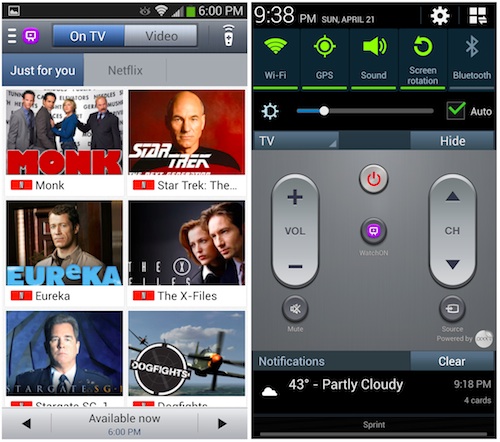 WatchON might be a different story, depending on how much of your entertainment comes from the old idiot-box in the living room. The Peel-powered app provides a personalized TV guide based on your location and cable provider, and it can analyze your watching patterns to recommend shows you might be interested in. It’s best leveraged with a Samsung television, of course, and a Google TV and Netflix account are handy as well.
WatchON might be a different story, depending on how much of your entertainment comes from the old idiot-box in the living room. The Peel-powered app provides a personalized TV guide based on your location and cable provider, and it can analyze your watching patterns to recommend shows you might be interested in. It’s best leveraged with a Samsung television, of course, and a Google TV and Netflix account are handy as well.
About the only other standalone capability it has comes courtesy of the IR port atop the Galaxy S 4, which allows you to control almost any TV and DVR. We were able to get about half of WatchON’s features working with our living room setup, and we got pretty good at changing the volume on our LG TV, especially once we figured out how to throw the remote control app into our notification shade. Beyond that, the experience kind of fell apart, probably due to our ancient DVR and small-time cable provider. Those with a more involved home-entertainment setup than us will probably have better luck, especially if that setup includes a newer Samsung flatscreen TV.
S Health and Story Album: The Lifestyle Push
 Samsung is no stranger to the concept of bloatware, but to its credit, it usually provides some pretty useful functionality along with the unasked-for software on its high-end devices. S Health is a pretty good example not just of a useful title, but of an app that intelligently takes advantage of the Galaxy S 4′s elaborate suite of sensors. Its Walking Mate function presses the phone’s accelerometer into service as a pedometer, and it uses the onboard thermometer and hygrometer to determine the ambient “comfort level” for exercise. S Health can also display realtime data, such as steps taken during a given run or walk, via a homescreen widget. It’s not an app we would necessarily have downloaded,
Samsung is no stranger to the concept of bloatware, but to its credit, it usually provides some pretty useful functionality along with the unasked-for software on its high-end devices. S Health is a pretty good example not just of a useful title, but of an app that intelligently takes advantage of the Galaxy S 4′s elaborate suite of sensors. Its Walking Mate function presses the phone’s accelerometer into service as a pedometer, and it uses the onboard thermometer and hygrometer to determine the ambient “comfort level” for exercise. S Health can also display realtime data, such as steps taken during a given run or walk, via a homescreen widget. It’s not an app we would necessarily have downloaded,  but because it was offered out-of-the-box and accompanied by a brightly colored icon, we gave it a try. It works fairly well, though users will want to be fastidious about pressing pause on the pedometer when they stop for a protein shake or a smoothie, or whatever it is you fit people are sipping on these days.
but because it was offered out-of-the-box and accompanied by a brightly colored icon, we gave it a try. It works fairly well, though users will want to be fastidious about pressing pause on the pedometer when they stop for a protein shake or a smoothie, or whatever it is you fit people are sipping on these days.
Story Album, the widget hanging out right above S Health on first power-on, takes a simpler tack. The “physical artifact creation” app is essentially an album-builder. It’s powered by a publishing company called Blurb, and it allows users to arrange their pictures into captioned templates which can then be printed and mailed to the user. A 20-page softcover starts at $8.95, which is either criminal extortion or the steal of the century, depending on your feelings toward physical media.
Story Album is one of those titles that a large percentage of users will probably delete immediately after the first power-on, but for those who miss the tactile feel of flipping through a paperbound collection of memories, it’ll be just the ticket – and it’ll be one less app they need to search for and download in the Google Play Store.
 The sum total of the Galaxy S 4 software experience is vintage Samsung. There are more features here than most users could even begin to make sense of, but there are helpful tutorials at every turn to minimize confusion. Almost everything can be tweaked and adjusted, but despite the added complexity, the experience is (mostly) smooth. The software’s cartoony look isn’t aging well alongside stock Jelly Bean’s cool smoothness and HTC’s hip minimalism, but it’s comfortable and straightforward, and it looks great on a 1080p display. The Galaxy S 4′s flavor of Android continues the work that catapulted Samsung to its lofty position at the top of the heap, and it does so with a consistency we can’t help but admire.
The sum total of the Galaxy S 4 software experience is vintage Samsung. There are more features here than most users could even begin to make sense of, but there are helpful tutorials at every turn to minimize confusion. Almost everything can be tweaked and adjusted, but despite the added complexity, the experience is (mostly) smooth. The software’s cartoony look isn’t aging well alongside stock Jelly Bean’s cool smoothness and HTC’s hip minimalism, but it’s comfortable and straightforward, and it looks great on a 1080p display. The Galaxy S 4′s flavor of Android continues the work that catapulted Samsung to its lofty position at the top of the heap, and it does so with a consistency we can’t help but admire.Camera
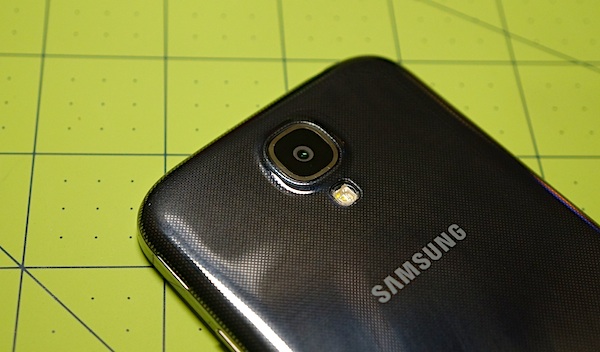 Fortunately, some of the Galaxy S 4′s software tweaks are much more exciting, and almost all of them are found in the camera app.
Fortunately, some of the Galaxy S 4′s software tweaks are much more exciting, and almost all of them are found in the camera app.
First things first: Samsung has bumped the specs of the camera hardware itself, replacing the 8MP shooter found on the Galaxy S III, Galaxy Note II, and ATIV S with a 13MP BSI unit capable of shooting 1080p video. While the upgrade in resolution is nice, users should take note up front that the default out-of-box setting is 9.6MP, not the maximum 13MP. In the 9.6MP mode, the resulting photos are output in a 16:9 aspect ratio, whereas the full 13MP mode renders photos in 4:3.
That means that, in default shooting mode, the Galaxy S 4 has a narrower field of view than most competitors in its class, due in part to the 16:9 cropping. A user therefore needs to stand further back from the subject in order to capture as much of the frame. That results in a moderately sharper image, but it also makes us feel perpetually too close to whatever we’re photographing. We’re used to seeing narrow field-of-view issues on midrange smartphones, but it’s disappointing to see it in evidence on the 2013 Galaxy S flagship due to the default settings.
On the bright side, there’s no shortage of ways to tweak the S 4′s camera settings, and thanks to some features ported from last year’sGalaxy Camera, that tweaking experience is easy, and even fun at times. Resolution and lighting settings are still kept out of the way behind a cog icon, but changing shooting modes is as easy as swiping a ribbon of oversized thumbnails, a one-handed operation that’s fluid and quick. The options range from once-in-a-while oddballs like Dual Shot:
… to mind-blowing multiple-exposure fun with Drama Shot:
… to Cinemagraph-aping GIF-making with Animated Photo:
True to form, Samsung went a little overboard with the camera features, and the collection certainly isn’t perfect; we doubt we’ll ever find much use for Sound & Shot, and we wish Samsung’s panorama app didn’t require the world’s steadiest tripod to avoid distortion. But unlike the other TouchWiz “enhancements” noted in the UI section above, all of the added camera features work well enough to pass the “why not” test. In other words, there was no reason not to include them, and we’ve had a lot of fun testing them.
In more conventional applications, the camera does well enough. Shots taken with default settings outdoors in bright daylight come out looking just fine, with appropriate saturation and contrast. The camera has a slight tendency to overexpose, though, and shots taken indoors are a much bigger crapshoot. We saw more noise in the S 4′s shots than we were expecting, and more than one photo taken indoors was beset by an unsightly gray pallor. The S 4′s camera seems especially sensitive to lighting conditions using the out-of-box settings.
In terms of video, outdoor performance is quite good at full 1080p resolution. Automatic settings produce a video that adjusts focus promptly, reproduces colors accurately, and maintains focus on quickly-moving objects without a problem. Audio is bright and loud, without much distortion in a light breeze.
Indoors, colors are just slightly grainier, but the Galaxy S 4′s microphone bears up well under the disparate conditions of sedate music and an arriving train. We’re not sure we’d want to take the S 4 to a concert, and its lightweight build means our shivering hands don’t always produce the smoothest output, but that’s what digital image stabilization is for (it’s turned off in each of these videos).
We’re approaching the point where mobile photography is so prevalent that the declaration “it takes great shots, for a phone” is almost a backhanded compliment. But that’s exactly what the Galaxy S 4 offers. It builds on the legacy of its predecessors, pushing the boundaries of fun smartphone photography forward through a balanced combination of specs and features. There aren’t any flashy buzzwords like “UltraPixel” or “PureView” here -and the mediocre low-light performance confirms that- but by and large, they’re not needed. Taken in total, the experience of shooting pictures on the Galaxy S 4 is an excellent one.
Performance
In synthetic benchmarks, the Galaxy S 4′s guts do it proud. The device keeps pace with the similarly equipped HTC One and lays waste to older smartphones packing last-generation hardware, at least on paper.
Update: Some folks brought to our attention a disparity between our benchmark results and those of other sites. We re-ran the GeekBench2, AnTuTu, SunSpider, and Quadrant Standard battery on both of our Sprint review units -one of them after a factory reset, the other after eight days’ use- and came up with the following results. Only the SunSpider scores show a significant deviation from our original findings.
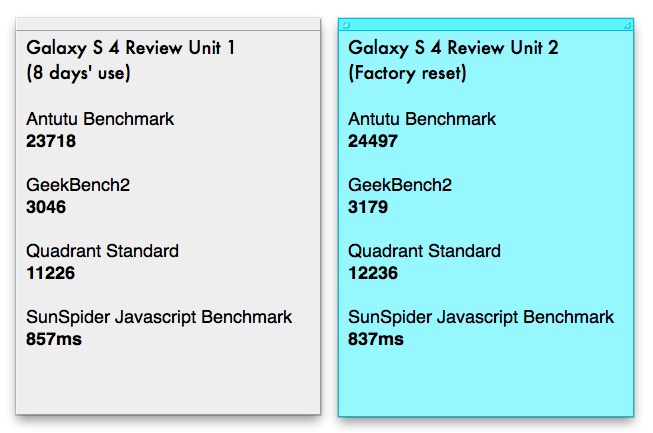
In the real world, the Galaxy S 4′s performance is almost as impressive. Streaming HD content via Netflix went off well enough, and the browser doesn’t choke on pages laden with heavy graphical content. App load times are brief enough not to mess with our flow, and modern gaming titles work well enough – though we did have some trouble with older games like Rise Of Glory on both the Galaxy S 4 and the HTC One. Whether this is due to the new generation’s 1080p displays or some other optimization problem, we don’t know. As always, buyers of new smartphones should take note that older apps may experience compatibility issues at first. Not to worry, pig-slayers: Angry Birds Star Wars plays just fine on the GS 4′s hardcore hardware.
 In normal, day-to-day operations, the Galaxy S 4 isn’t quite as zippy as we’re used to seeing from Samsung hardware. Frames routinely drop during app opening and closing animations, and a slight lag pervades a few corners of the OS. Again, there might be some optimization yet to happen on the software side of things; an over-the-air update should clear up these minor bumps. Still, it’s disconcerting to see any lag on such a powerful device supposedly running final software.
In normal, day-to-day operations, the Galaxy S 4 isn’t quite as zippy as we’re used to seeing from Samsung hardware. Frames routinely drop during app opening and closing animations, and a slight lag pervades a few corners of the OS. Again, there might be some optimization yet to happen on the software side of things; an over-the-air update should clear up these minor bumps. Still, it’s disconcerting to see any lag on such a powerful device supposedly running final software.
Audiophiles have something to look forward to in the Galaxy S 4: Samsung’s relocation of the speakerphone to the lower half of the phone apparently freed up some space to make it bigger as well, and the new module is loud. While we’d still prefer a front-firing speaker -better yet, a pair of them- the increased output really helps when gaming, watching video, or playing music. For more private listening, Samsung has bundled redesigned earbuds with the Galaxy S 4; the device’s output through the headphone jack seems well-balanced, matching the HTC One in volume and even keeping up in terms of bass. Casual listeners should find little to complain about.
Battery Life
 Testing smartphone battery life is difficult. There are hundreds, perhaps thousands of variables that affect power consumption on a mobile device, and everyone uses his or her smartphone differently. In our experience, while homegrown tests like continuous video playback do offer concrete benchmarks for comparisons, they’re not terribly applicable to the real world. Anecdotal reports are by their very nature less precise, but we find them more useful to a greater number of readers.
Testing smartphone battery life is difficult. There are hundreds, perhaps thousands of variables that affect power consumption on a mobile device, and everyone uses his or her smartphone differently. In our experience, while homegrown tests like continuous video playback do offer concrete benchmarks for comparisons, they’re not terribly applicable to the real world. Anecdotal reports are by their very nature less precise, but we find them more useful to a greater number of readers.
Nevertheless, in an effort to improve our battery testing methodology, we’ve begun using AnTuTu Tester to provide some baseline metrics. In our week-long review period, we’ve run the Galaxy S 4 through the app’s battery test several times. Our test unit consistently scores a 470, higher than that of the Sprint HTC One, which scores a 408.
 In real-world use, the Galaxy S 4 usually got us through a day of moderate to heavy use. One particular test is illustrative of a typical “heavy” day: on this occasion, the device hopped between WiFi, 3G, 4G LTE, and no-service conditions continuously as we traveled across town, underground on the subway, and in and out of buildings. One Gmail and one Exchange email account continuously fetched emails, while Facebook, Twitter, and Instagram apps simultaneously listened for updates. We browsed, tweeted and emailed occasionally, texted often, and used Google Maps and Google Navigation for a total of 90 minutes. Between two and three brief phone calls were exchanged. In this “heavy” usage pattern, the device lasted twelve hours from full charge to exhaustion.
In real-world use, the Galaxy S 4 usually got us through a day of moderate to heavy use. One particular test is illustrative of a typical “heavy” day: on this occasion, the device hopped between WiFi, 3G, 4G LTE, and no-service conditions continuously as we traveled across town, underground on the subway, and in and out of buildings. One Gmail and one Exchange email account continuously fetched emails, while Facebook, Twitter, and Instagram apps simultaneously listened for updates. We browsed, tweeted and emailed occasionally, texted often, and used Google Maps and Google Navigation for a total of 90 minutes. Between two and three brief phone calls were exchanged. In this “heavy” usage pattern, the device lasted twelve hours from full charge to exhaustion.
Power users are advised to remember that the Galaxy S 4 represents an especially dense collection of power-sucking features. Between the LTE radio, high-speed CPU, bright 1080p display and other energy-drainers, the device has the capacity to exhaust even a larger battery quite quickly. Fortunately, the removable power pack means heavy users will be able to tote around an extra battery with little fuss, should they feel the need.
Call Quality/Network Performance
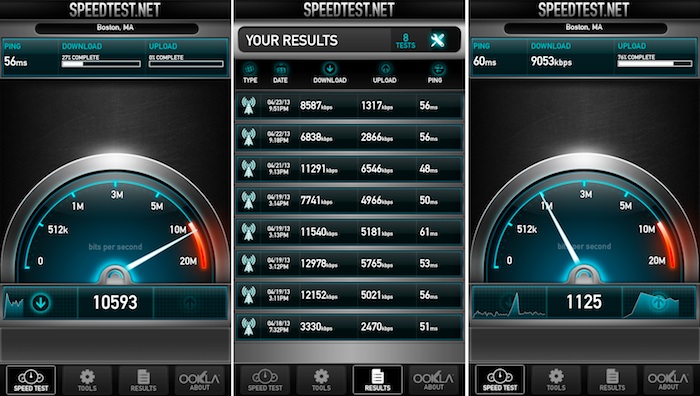 Our testing period took us from the streets of New York City to the suburbs of Greater Boston to the docks of Salem, and everywhere in between. The device’s reception appears excellent; our two Galaxy S 4 demo units routinely show stronger signal than our HTC One, with the difference usually on the order of 15-20 dBm between them. That’s a significant gulf, and it gives us confidence that the Galaxy S 4′s radio is well-suited to its primary task.
Our testing period took us from the streets of New York City to the suburbs of Greater Boston to the docks of Salem, and everywhere in between. The device’s reception appears excellent; our two Galaxy S 4 demo units routinely show stronger signal than our HTC One, with the difference usually on the order of 15-20 dBm between them. That’s a significant gulf, and it gives us confidence that the Galaxy S 4′s radio is well-suited to its primary task.
A smartphone is only as solid as its network, though, and the Now Network still isn’t mature enough in our area to deliver the kind of reliable performance that its more-established competition can. Speeds over LTE were moderate to good; we averaged about 10 Mbps down and 4 to 5 Mbps up during our test period, when we could get signal. All too often, though, we found ourselves with slower throughput -particularly indoors- and rather severe connectivity problems in fringe areas. Sprint’s CDMA roaming agreements with Verizon Wireless are theoretically meant to ensure that customers have service even outside of Sprint’s coverage areas; in practice, our Galaxy S 4 waffled indecisively between networks, often holding on to an unusably bad Sprint signal instead of jumping over to a strong Verizon Wireless one. Hey, we get it, Sprint: you need to save money. But providing a bad experience in fringe areas isn’t the way to do it.

Orange dots = bright points of LTE joy in a purple sea of EvDO despair.
Call quality is another low point for the Galaxy S 4. In a battery of “blind” phone tests, callers gave us only an average grade -7 out of 10- for audio quality, with more than one conversation partner telling us we sounded “muddy.” When asked to compare audio quality with the older Galaxy S III, callers couldn’t decide which phone we sounded better on – but everyone agreed we sounded significantly clearer on the Galaxy Note II than we did on the Galaxy S 4. Noise cancellation was also disappointing, our conversation easily disrupted by a stiff breeze, and audio quality on our end was similarly unimpressive. The calling experience isn’t necessarily bad on the Galaxy S 4; it’s just decidedly average. That’s not the kind of performance we’ve come to expect from flagship smartphones.
Pros
+ Beautiful display
+ Large removable battery
+ Expandable storage
+ Solid camera with excellent feature set
+ Elaborate sensor and radio package
+ Some software features show potential
+ Large removable battery
+ Expandable storage
+ Solid camera with excellent feature set
+ Elaborate sensor and radio package
+ Some software features show potential
Cons
- Uninspiring aesthetics
- Dated UI with only average responsiveness
- Samsung features are more gimmick than useful addition
- Mediocre call quality
- Dated UI with only average responsiveness
- Samsung features are more gimmick than useful addition
- Mediocre call quality
Pricing and Availability
Like its predecessor, the American version of the Galaxy S 4 will eventually be offered by all four U.S. national carriers. Samsung has its own pre-release info hub, including carrier and retailer information, here. Radio Shack announced yesterday that the Sprint and AT&T versions would be available starting April 27, and preorders are currently open at AT&T, Sprint, T-Mobile USA, U.S. Cellular, Best Buy, and Walmart.
The full retail price varies across sales channels and depends on device capacity, but AT&T quotes a cost of $639.99 for the 16GB version ($199.99 on contract). The retail version of our 16GB Sprint variant will sell for $599.99 from the nation’s yellowest carrier, but discounts and promotions can bring that cost down as low as $149.99 on a contract.
Conclusion
 Contrary to what the extreme sides of the pro and con camps would have you believe, the Galaxy S 4 is neither an overachieving champion, nor crushing disappointment. But with its powerful feature set and lofty legacy, it’s also not by any means “average.”
Contrary to what the extreme sides of the pro and con camps would have you believe, the Galaxy S 4 is neither an overachieving champion, nor crushing disappointment. But with its powerful feature set and lofty legacy, it’s also not by any means “average.”
The Galaxy S 4 is, instead, exactly what it needs to be – and nothing more. It’s a device that offers just enough improvement over its immediate predecessor to justify its existence, just enough to give penny-pinching buyers the appropriate measure of pause before trying to save some dough by picking up last year’s model. Its conservative design lacks the degree of inspiration we love seeing in flagship smartphones, and its software is too weighed down with half-baked gimmicks for our taste – but ultimately it’s a solid instrument.
There will come a day when Samsung can’t rely on iterative upgrades and dubious “features” to capture attention and sell smartphones. That day, however, is not today. While the company will no doubt feel a bit of pressure to innovate more extensively going forward, it will still sell millions upon millions of Galaxy S 4s in the meantime. And based on what we’ve seen during our time with the unit, that’s a pretty good thing.
Scored For Me
___
Special Scoring Note: Although the review unit provided by Samsung was a Sprint variant, the indicated score represents our ranking of the American Galaxy S 4 as a whole. Were we to rank this device while taking into account the carrier experience, we would award it a score of 8.4.




























No comments:
Post a Comment